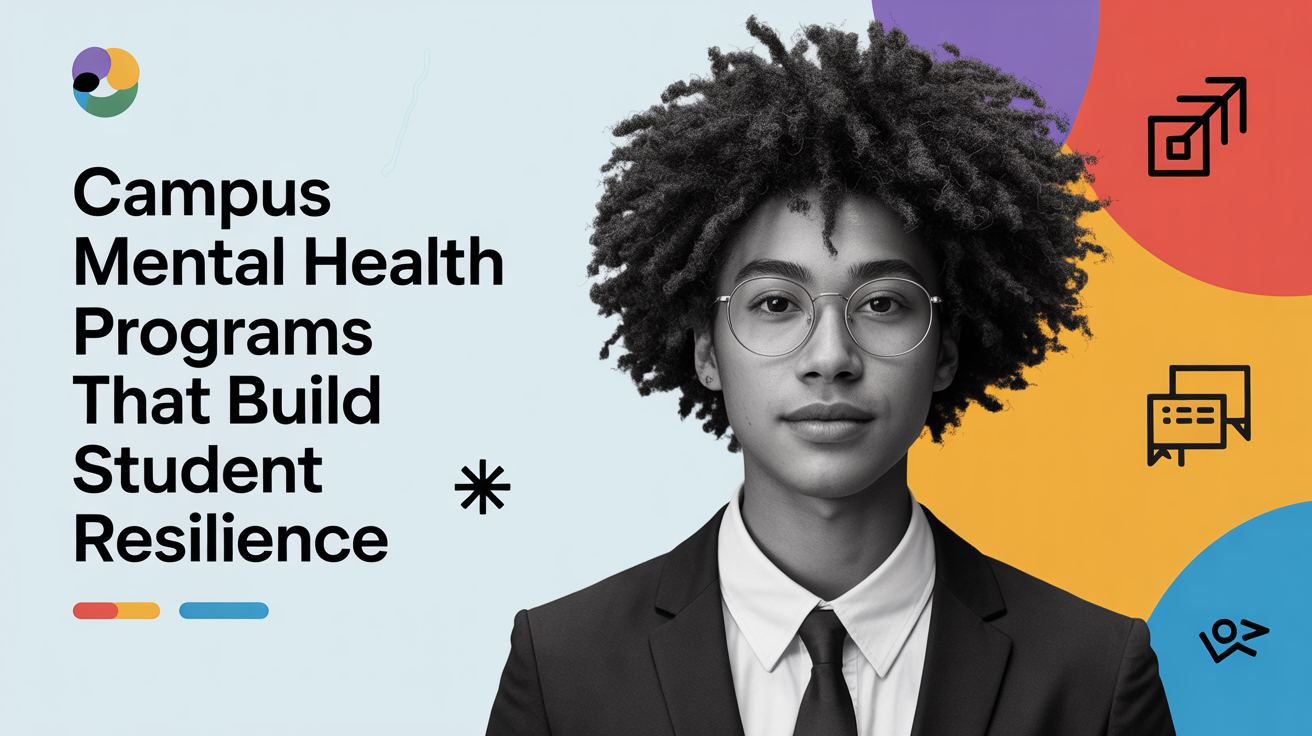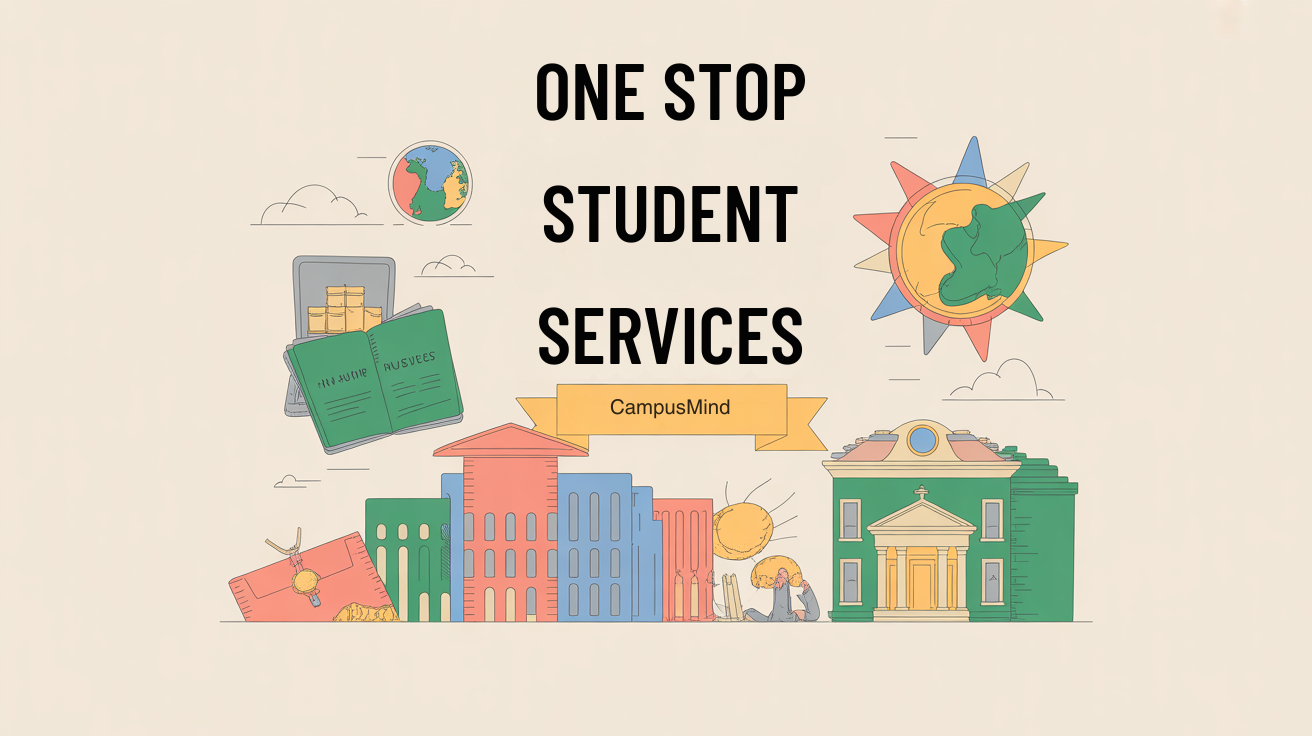College students are facing real mental health challenges. But there's good news: campuses with comprehensive campus mental health programs are seeing significant improvements.
The 2024-2025 Healthy Minds Study surveyed over 84,000 students and found encouraging trends. Severe depression dropped to 18% in 2025 from 23% in 2022, while suicidal thoughts decreased to 11% from 15%. These aren't just statistics—they represent thousands of students who got the support they needed.
So what’s working? Let’s explore the campus mental health programs that are making a real difference for college students.
Why Campus Mental Health Programs Matter for Retention
Here's something every dean knows but doesn't always say out loud: mental health directly impacts whether students stay in school.
Over half of students (51%) have skipped class due to mental health struggles. One in three failed a test, and 29% failed an entire class. Even more concerning, 26% of students took a leave of absence because of mental health challenges.
When students struggle mentally, everything else falls apart—grades, relationships, engagement. That's why smart institutions treat mental health as a retention strategy, not just a student services issue.
The Five Pillars of Effective Campus Mental Health Programs

1. Accessible Counseling Services
Traditional counseling centers remain essential, but they can't be the only option. The best programs combine on-campus counselors with flexible alternatives.
About 37% of students received therapy or counseling in the past year, which sounds good until you realize that means 63% didn't access care—even though many needed it.
Successful programs place counselors where students actually are: in residence halls, academic buildings, and student centers. This "embedded counseling" model reduces the stigma of walking into a counseling center and makes help feel more accessible.
2. 24/7 Teletherapy Options
Students don't have mental health crises between 9 and 5 on weekdays. They need support at midnight before a big exam, during summer break, and on weekends.
Teletherapy vendors now serve millions of students at over 700 campuses. These platforms connect students with licensed therapists through video calls, often within 24-48 hours of reaching out.
The numbers tell the story: 37% of California students using TimelyCare accessed services outside regular counseling center hours. Students appreciate the convenience—no commute, no waiting room anxiety, just help when they need it.
One student at Sacred Heart University shared that without teletherapy, she went six weeks without her medication after moving to campus because she couldn't find an in-state psychiatrist. Teletherapy solved that problem immediately.
3. The JED Framework for Comprehensive Care
The JED Foundation offers one of the most evidence-based approaches to campus mental health. Their JED Campus program works with schools over four years to build comprehensive systems.
The results speak for themselves. Students at schools that completed the JED Campus program were 25% less likely to attempt suicide, 13% less likely to make a suicide plan, and 10% less likely to experience suicidal ideation.
What makes JED effective? It's not just about counseling services. The framework addresses policy changes, gatekeeper training (teaching staff to recognize distress), life skills education, substance abuse prevention, and crisis management protocols.
JED recognizes a crucial truth: everyone on campus plays a role in student mental health, from faculty who notice when a student stops attending class to RAs who check in on isolated residents.
4. Peer Support Networks
Sometimes students just need to talk to someone who gets it—another student who's been there.
Peer support programs train students to provide emotional support, recognize warning signs, and connect their peers with professional help. These programs work because they reduce stigma. Talking to a peer supporter in the dining hall feels different than making an appointment at the counseling center.
Loneliness decreased from 58% in 2022 to 52% in 2025, suggesting that connection matters. Peer programs create those connections while also building a safety net of people looking out for each other.
5. Proactive Wellness Programming
The best mental health programs don't wait for crises. They teach skills before students need them.
Resilience workshops, stress management seminars, mindfulness sessions, and healthy relationship programs give students tools to handle challenges. Students said scheduled mental health days (42%), acknowledging mental health needs (35%), wellness activities (32%), and life skills classes (30%) would help support their mental health.
Think of it like this: you wouldn't wait until students are failing to offer academic support. Why wait until they're in crisis to teach emotional coping skills?
What Students Actually Want
When we ask students what would help, their answers are surprisingly straightforward.
They want flexibility. They want options. They want support that fits into their actual lives—which include part-time jobs, commutes, caregiving responsibilities, and packed schedules.
Students find teletherapy "convenient, accessible, easy to use and helpful," mostly due to expanded therapist availability. They're not rejecting traditional counseling; they just need more pathways to care.
Students also want their institutions to acknowledge that mental health struggles are normal, not shameful. Only 7% of students would think less of someone who received mental health treatment. The stigma they worry about? It's fading.
Measuring What Matters

How do you know if your mental health programs are working? You measure both access and outcomes.
Access Metrics:
How many students use counseling services?
What's the average wait time for appointments?
How many students access after-hours support?
Are services reaching diverse student populations?
Outcome Indicators:
Are symptom severity scores improving?
Are retention and graduation rates increasing?
Do students report feeling supported?
Are crisis interventions decreasing over time?
TimelyCare data shows that students who entered care with severe symptoms achieved clinically significant improvement by their third session. That's the kind of outcome data that matters—not just counting appointments, but tracking whether students are actually getting better.
Creating a Culture of Care
Programs and services matter, but culture matters more. The most effective campuses weave mental health awareness throughout the student experience.
It starts before students arrive. Send incoming students information about mental health resources. During orientation, normalize help-seeking. Have peer leaders share their own experiences with campus support services.
Throughout the academic year, maintain visible messaging. Train faculty to recognize distress and make warm referrals. Empower RAs and student organization leaders. Make mental health part of the conversation, not something whispered about in private.
While only 7% of students personally would judge someone for getting help, 41% believe others would. That gap between personal acceptance and perceived stigma shrinks when campuses openly prioritize mental health.
The Bottom Line
Student mental health programs aren't optional extras or nice-to-haves. They're essential infrastructure for student success.
The encouraging trends in recent data—three consecutive years of declining depression, anxiety, and suicidal ideation—suggest that comprehensive approaches work. When campuses invest in accessible counseling, teletherapy options, evidence-based frameworks like JED, peer support, and proactive programming, students thrive.
As one researcher noted, these sustained improvements aren't a blip. Whether due to post-pandemic recovery, better institutional support, or other factors, they represent real progress in supporting young people's mental health.
The question isn't whether to invest in campus mental health programs. It's how to build the most effective, accessible systems that help every student who needs support.
Ready to strengthen your campus mental health approach? Explore how Campus Mind connects students with resources and builds campus community. Learn about our comprehensive student engagement platform.
Works Cited
[1] University of Michigan School of Public Health — "Healthy Minds Study: College student depression, anxiety decline for third consecutive year." https://sph.umich.edu/news/2025posts/college-student-mental-health-third-consecutive-year-improvement.html. Published: 2025-09-09. Accessed: 2025-10-18.
[2] Boston University School of Public Health — "Severe Depression, Anxiety, Suicidal Thoughts Continue to Decrease Among College Students." https://www.bu.edu/sph/news/articles/2025/college-students-reports-of-depression-anxiety-suicidal-thoughts-continue-move-in-positive-direction/. Published: 2025-09. Accessed: 2025-10-18.
[3] Harmony Hit — "College Students and Mental Health - New Survey Data." https://www.harmonyhit.com/college-student-mental-health-stats/. Published: 2025-03-10. Accessed: 2025-10-18.
[4] The Jed Foundation — "Our Approach." https://jedfoundation.org/our-approach/. Published: 2020-07-26. Accessed: 2025-10-18.
[5] BestColleges — "College Student Mental Health Statistics." https://www.bestcolleges.com/research/college-student-mental-health-statistics/. Published: 2023-02-15. Accessed: 2025-10-18.
[6] Georgetown Feed — "The rise of online therapy services on college campuses." https://feed.georgetown.edu/access-affordability/the-rise-of-online-therapy-services-on-college-campuses/. Published: 2024-01-19. Accessed: 2025-10-18.
[7] University of Michigan School of Public Health — "College students' mental health improving, more finding support." https://sph.umich.edu/news/2024posts/college-students-mental-health-improving-more-finding-support.html. Published: 2024-09-11. Accessed: 2025-10-18.
[8] TimelyCare — "Virtual Health & Well-Being for Higher Education." https://timelycare.com/. Published: 2022-10-12. Accessed: 2025-10-18.
[9] Higher Ed Dive — "Colleges use teletherapy to support students outside of the academic year." https://www.highereddive.com/news/colleges-use-teletherapy-to-support-students-outside-of-the-academic-year/625532/. Published: 2022-06-27. Accessed: 2025-10-18.
[10] MindShift — "Talk now: How community colleges are using teletherapy to transform student mental health services." https://www.kqed.org/mindshift/60607/talk-now-how-community-colleges-are-using-teletherapy-to-transform-student-mental-health-services. Published: 2022-12-18. Accessed: 2025-10-18.
Frequently Asked Questions
What are the most effective campus mental health programs?
The most effective programs combine multiple approaches: accessible on-campus counseling, 24/7 teletherapy options, evidence-based frameworks like JED Campus, trained peer supporters, and proactive wellness programming. Research shows that 37% of students now access therapy or counseling, with improvements in depression and anxiety symptoms when comprehensive support systems exist. Programs work best when they meet students where they are—both physically and in terms of scheduling flexibility.
How does teletherapy compare to in-person counseling for college students?
Teletherapy delivers comparable outcomes to in-person therapy while dramatically improving access. Students using platforms like TimelyCare achieve clinically significant improvement by their third session. The key advantage is availability: 37% of students access teletherapy outside regular counseling center hours. Students report finding it convenient, accessible, and easy to use. However, teletherapy works best as a complement to—not replacement for—on-campus services, giving students multiple pathways to care.
What is the JED Campus program and does it work?
JED Campus is a four-year structured program that helps colleges build comprehensive mental health and suicide prevention systems. It addresses policy, training, life skills education, substance abuse prevention, and crisis protocols—not just counseling services. The results are significant: students at schools completing JED Campus were 25% less likely to attempt suicide, 13% less likely to make suicide plans, and 10% less likely to experience suicidal ideation. Over 400 campuses currently participate in the program.
How much do college students' mental health issues affect academic performance?
Mental health significantly impacts academic outcomes. Over half of students (51%) have skipped class due to mental health struggles, one in three failed a test, and 29% failed an entire class. Most concerning, 26% of students took a leave of absence from school because of mental health challenges. This direct link between mental health and retention explains why effective mental health programs are actually retention strategies that improve graduation rates while supporting student wellbeing.
What do college students want from campus mental health services?
Students want flexibility, multiple options, and reduced stigma. They prioritize scheduled mental health days (42% say this would help), acknowledgment of mental health needs (35%), wellness activities (32%), and life skills classes (30%). They want services that fit their actual lives—including evening and weekend access, teletherapy options, and support that doesn't require navigating complex systems. Only 7% would judge someone for seeking help, showing that peer acceptance exists even when students worry about stigma.




